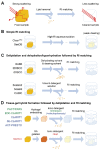Clearing and Labeling Techniques for Large-Scale Biological Tissues
- PMID: 27239813
- PMCID: PMC4916395
- DOI: 10.14348/molcells.2016.0088
Clearing and Labeling Techniques for Large-Scale Biological Tissues
Erratum in
-
Erratum to: Clearing and Labeling Techniques for Large-Scale Biological Tissues.Mol Cells. 2019 Jan 31;42(1):96. doi: 10.14348/molcells.2019.1088. Mol Cells. 2019. PMID: 30622232 Free PMC article.
Abstract
Clearing and labeling techniques for large-scale biological tissues enable simultaneous extraction of molecular and structural information with minimal disassembly of the sample, facilitating the integration of molecular, cellular and systems biology across different scales. Recent years have witnessed an explosive increase in the number of such methods and their applications, reflecting heightened interest in organ-wide clearing and labeling across many fields of biology and medicine. In this review, we provide an overview and comparison of existing clearing and labeling techniques and discuss challenges and opportunities in the investigations of large-scale biological systems.
Keywords: 3D volume imaging; CLARITY; SWITCH; large-scale tissue clearing; stochastic electrotransport; whole-mount labeling.
Figures

References
-
- Bolin F.P., Preuss L.E., Taylor R.C., Ference R.J. Refractive index of some mammalian tissues using a fiber optic cladding method. Appl. Opt. 1989;28:2297. - PubMed
-
- Choi B., Tsu L., Chen E., Ishak T.S., Iskandar S.M., Chess S., Nelson J.S. Determination of chemical agent optical clearing potential using in vitro human skin. Lasers Surg. Med. 2005;36:72–75. - PubMed
Publication types
MeSH terms
LinkOut - more resources
Full Text Sources
Other Literature Sources

